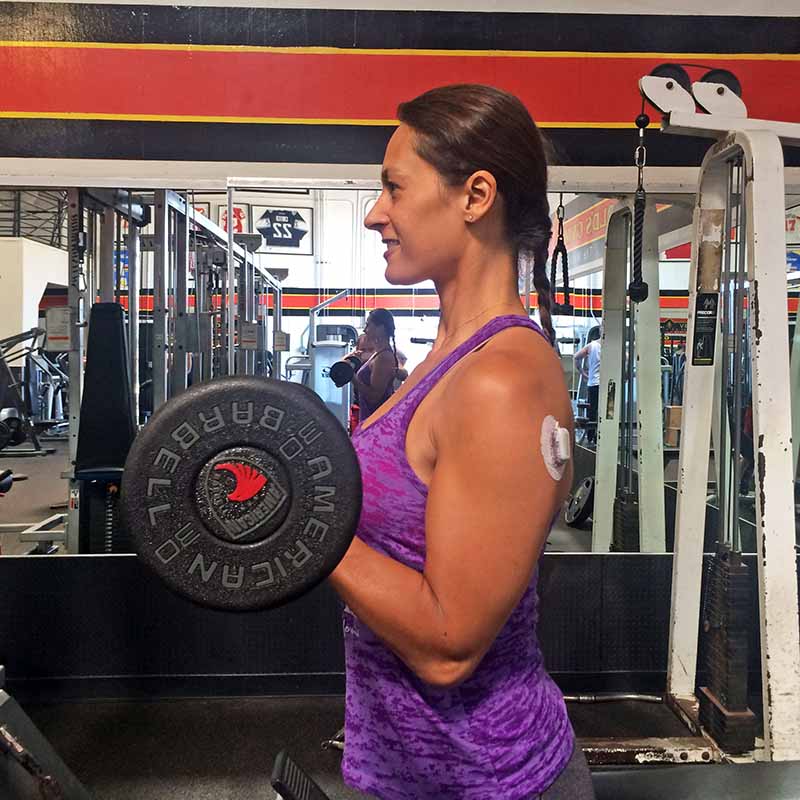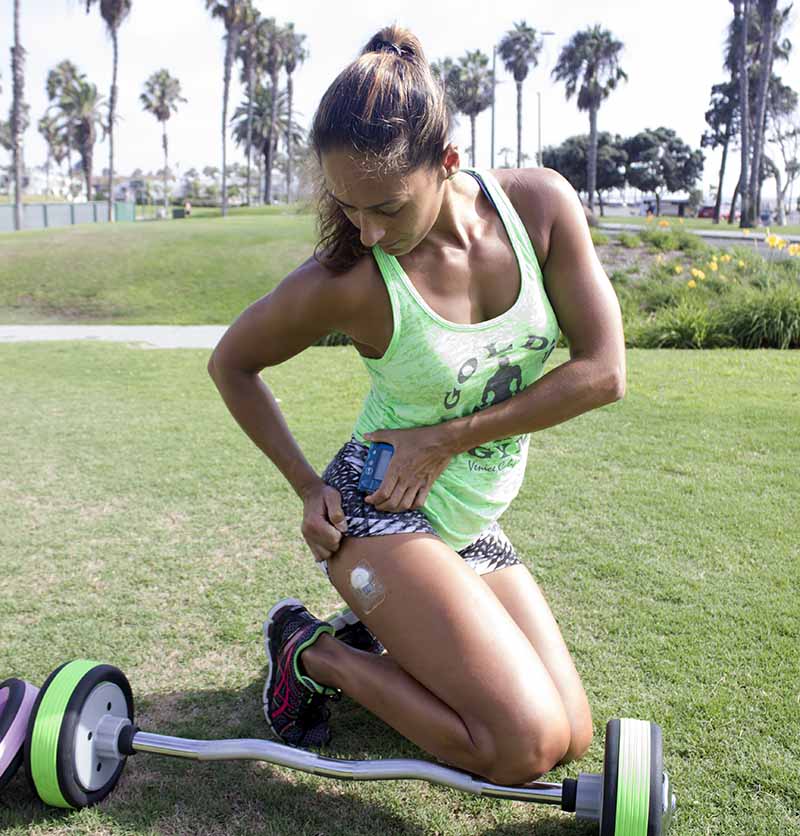You’ve probably seen me wearing a small device on my upper arm in a lot of the pictures on this website. That’s my continuous glucose monitor (CGM), a tool that’s instrumental in my daily diabetes management.
It’s a brilliant piece of equipment, and I absolutely love it (most of the time).

What is CGM?
A CGM device makes it possible for me to see my glucose readings in (almost) real-time and to track historical glucose data.
Most CGMs include three main components:
- A small sensor that is inserted just under the skin (where it reads glucose levels in interstitial fluid, or the fluid between body cells)
- An attached transmitter (this is the part you see on my arm), which sends the readings to a receiving device
- A receiver or smartphone that displays the readings and glucose trend data
There are currently several CGM systems available for personal use in the United States:
- Abbott FreeStyle Libre 2
- Abbott FreeStyle Libre 3
- Ascensia Diabetes Care Eversense E3 (a fully implantable option)
- Dexcom G6
- Dexcom G7
- Medtronic Guardian Connect
My experience with CGM
I got my first Medtronic CGM in December 2012 and wore it every day for 18 months before taking a break. I then ordered my first Dexcom system in August 2016, and that has been my go-to since.
There are pros and cons to all CGM systems. Since I’ve only worn Medtronic and Dexcom devices to date, I’ll give you my opinions based on those so you can decide if a CGM might help you manage your diabetes better.
The advantages of CGM
Data
If you do finger-stick blood sugar checks and know your body well, you probably think you have a pretty good idea of what your sugars are up to between measurements. Chances are good, though, that you may be wrong.
I got a big surprise when I started seeing how much my blood sugar actually varied throughout the day, not to mention during the night when I usually don’t check.
CGM is a vital tool for providing this type of ongoing information over a 24-hour period that can show trends and patterns, as opposed to the snapshots at certain times during the day that are provided by traditional monitoring.
All of a sudden, I could see how certain foods and activities affected my glucose levels over the next several hours. That information is golden!
Plus, being able to spot low sugars before they hit (thanks to the alerts I set for when my sugar levels start dropping or get to a certain point) has really cut down on how often I have low blood sugar episodes.
It also means I’m consuming fewer glucose tablets and less juice to deal with said lows, because I’m catching them earlier when less intervention is required to get my blood sugar back to target range.
Management
So, what to do with all this new information? In my case, it has not only helped me limit episodes of hypoglycemia (low blood sugar), but I have also managed to reduce my A1c level (a measure of glucose control over the previous 2 to 3 months) to around 6.0 percent.
My blood sugar has always been pretty well-regulated but has never been this stable before.
What’s more, some current CGM devices can integrate with an insulin pump, allowing you to monitor both glucose and insulin levels at the same time.
And certain devices combine CGM and insulin pump technology with an algorithm that automatically adjusts insulin dosing to help glucose stay within target range (the optimal level as determined by a person’s healthcare provider), in an innovation known as hybrid-closed loop (HCL) technology.
Current HCL devices on the market include:
- Medtronic MiniMed 770G
- Medtronic MiniMed 780G
- t:slim X2 Insulin Pump with Control-IQ Technology + Dexcom G6/G7
- Insulet Omnipod 5
Of course, just slapping on a CGM won’t manage your diabetes. But careful interpretation and use of the data can help immensely.
For instance, I’ve learned that if I sleep any later than 8 a.m. before taking my morning insulin, I’ll be battling high morning blood sugar levels until at least noon.
I’ve also learned what kind of activities will make my sugars drop fast (in my case, that would be walking), my true levels of insulin sensitivity throughout the day, and that I always need a minimum of a half unit of active insulin on board (IOB) before a workout.
Gaining this knowledge took time and did include a few missteps, but that’s life and that’s learning. The information has made it possible for me to optimize my training and has made it easier for me to stay in my desired range of 90 to 144 mg/dL (5.0 to 8.0 mmol/L) when exercising.
Confidence and security
My CGM has enabled me to understand my diabetes better. It has given me more confidence in the way I manage my condition and has helped me achieve tangible results.
It’s also comforting to know how my sugar levels are trending. I will even venture out sometimes without bringing all my diabetes gear. I also stopped monitoring 10 to 12 times a day because I no longer need to — the information is always right there on the screen in front of me.
Using this device has enabled me to go for a walk or a hardcore gym session without fearing lows and to reach both my fitness and diabetes health goals more efficiently.

The disadvantages of CGM
Accuracy
Anybody who has ever worn a CGM knows the frustration of doing a traditional finger-stick check and seeing that the sensor reading is off.
The reason behind this is that the technology isn’t perfect yet (although it is constantly improving) and the sensor measures your glucose levels in the interstitial fluid and not the blood. (There is generally a lag of a few minutes between your interstitial glucose levels and blood glucose levels)
Aside from the obvious issues, it can also be outright dangerous if you rely solely on the sensor readings and completely ignore what your body is telling you. For example, if the CGM alarms are going off telling you that you are at 250 mg/dL (13.9 mmol/L), it can be hard not to immediately react.
I have also had to stop workouts because the sensor incorrectly told me that my blood glucose was low or about to get low — always an annoying scenario when you’re in the midst of a good gym session.
Although some CGM devices are now highly accurate and approved by the U.S. Food and Drug Administration (FDA) for making treatment decisions, it is always wise to confirm any unexpected readings or readings that don’t match what your body is feeling with a traditional finger-stick before taking action.
(And several of the devices on the market, including the Medtronic Guardian and the Ascensia Eversense E3, require roughly two finger-stick checks a day for calibration.)
That said, it’s worth noting that the technology has improved tremendously over the years. According to a 2023 study, CGMs were shown to be 96.5 percent accurate in a real-world hospital setting.
Overreliance
This is actually the main reason why I originally stopped wearing my CGM and why I still take breaks on occasion.
This may not apply to everyone, but I have a tendency to rely on the readings and recommendations a bit too heavily. For example, if the reading said that my glucose was dropping quickly, I would trust it fully over how I actually feel. I think that’s a big no-no when it comes to diabetes management. In this scenario, it would be prudent to confirm the CGM information with a finger-stick check.
I have gotten a lot better at using the CGM as a data point and not necessarily as the complete truth, which has made it a far better partner in management.
Inconvenience
Having the CGM sensor attached to my body all the time can be extremely annoying. It’s not very big and people don’t really notice it, but it can leave somewhat unattractive suntan marks, and I also tend to scar easily.
If I wear it on my stomach, it tends to get in the way when working out, so I usually wear it on my upper arm. I find that I get pretty good readings with that placement. (One issue, though, is that it can be a little hard to get a sweaty sports bra off without ripping at the sensor.)
Wearing it on my upper arm has led to some pretty cool interactions and conversations with curious people. I don’t mind — I see it as an opportunity to educate and advocate.
But if it bothers you, there are plenty of other areas to place the sensor where it’s not visible. Typical manufacturers’ recommendations for sensor placement include the upper arm, stomach, lower back, thigh, and buttocks, depending on the specific device you’re using.
There are adhesives that can help strengthen the CGM’s adherence to your body. Refer to the instructions that come with your CGM and speak with your diabetes care provider about approaches that can work for you.
On a related topic, many people wonder if CGMs hurt. In my experience, there is only a slight pinching sensation upon inserting the sensor, and this momentary discomfort is well worth the data the device provides.
Plus, for the devices currently on the market, the sensors only need to be changed every 7 to 10 days (with the exception of the implantable Eversense E3, which typically needs to be changed by a healthcare provider every 90 days).
Related: Here is a post outlining my best CGM tips in which I talk more about how to put on the sensor (with a video) and how to make it stay on.
Price
Depending on your health insurance coverage, CGM devices and their associated supplies can be expensive. Check with your insurance provider to determine what costs are associated with CGM for you.

Final thoughts
Would I recommend a CGM to anyone with diabetes using insulin? The answer is a resounding yes, at least until you understand your body and your diabetes better.
The CGM will give you knowledge about your diabetes that you have never had before, and if after a while you feel like you no longer need it, speak with your diabetes care provider about other options.
The key for me when using my CGM is to get better at listening to both the CGM and my body. It’s a fantastic device, but it’s not a substitute for my own thinking and experience.
It’s a great tool to have in my diabetes toolbox, but it can’t stand alone.





Sue Cain
Hi, I have also worn the G6 for a couple of months. I have had Medtronic pumps for about 12 years. I am 75 and have been a Type 1 for 41 years. My A1C averages 7.0 and that is where the Endo wants it for my age and health. I have found the G6 to be very useful as well as very annoying. If there is no extra tape of some kind it can fall off in as little as 6 days instead of the full 10 days it is suppose to stay on. The first extra tape I used was clear with adhesive of some kind. It was so stiff and uncomfortable that I gave up on it so I am happy to see your recommendation. I have been told that Medicare does not cover the G6 and I have had to payout of pocket for all of it. Its pretty pricey so having one fall off is not good at all.
The G6 instructions show that it to be worn on a side just above the waist so I am surprised that you wear it on your arm. Perhaps I don’t have complete information. Thank you for your column, its very helpful.
Christel Oerum
Yes, I agree wholeheartedly, CGM can be very useful and very annoying!
I too dislike the clear plastic patches (Dexcom gives those away for free). My skin can breathe and gets very red and irritated. Plus as you mentioedn it’s too stiff.
As for the placement of the Dexcom G6. It’s only FDA approved for the abdomen, meaning that Dexcom only submitted clinical data with people wearing it in that place, for FDA to review. I’ve seen people wear it anywhere below the neckline (you’ll never see me wearing it on my calf or forearm though) with great success. However, just to reemphaise, it’s not FDA approved and Dexcom is not responsible if you place it anywhere else than the abdomen
Debbie
I have another year before I go on Medicare. I was told by Walgreens, who distributes the Dexcom G6 that Medicare does cover it!
Jane
Started on G5 and Medicare actually made
me switch to G6 So yes they do cover.
Mary
Medicare does pay. Have your doctor send the prescription to Walgreens. They are the only pharmacy that I know of that can do it.
Nickhil
Hello Christel I heard about CGM on the Peter Attia podcast. I was intrigued enough to do a google search and found this article which I found very helpful. I am pre-diabetic but the idea of being able to get continuous insights into what is and isn’t spiking my blood sugar is intriguing enough for me to try it out. My question to you is whether it is recommended for someone not with type 1 or 2 diabetes to use it or are there are any downsides? Thanks again for sharing your thoughts.
Christel Oerum
It’s a prescription device so you’ll have to get your doctor to prescribe it for you. I don’t see any downsides as such for you to use it except that your insurance might not pay for it. Generally, they only reimburse CGM for people managing their diabetes with insulin.
If it’s excessively expensive you can look into Libre. That’s a fingerstick replacement device and since you’re not on insulin it might be enough for you since you’ll still see the trends just not get alarms and alerts (which you technically don’t need when not using insulin)
Vanessa
I really appreciate your articles. Thank you for all the helpful information.
My question is if you are able to put pressure on the Dexcom cgm? For example if you are a side sleeper? Are the readings still accurate, does the sensor still last as long?
I really want to try a different location for the cgm. I appreciate any help you can give me.
Thank you
Christel Oerum
That’s a really good question. It definitely doesn’t hurt to put pressure on it and I’ve slept on mine more times than I can count (I’m a side sleeper). For me, 90% of the time it doesn’t matter. And then there are those few times where pressure seems to be messing with the readings.
Vanessa
Thank you for responding! I am thinking I will give it a try.
Marcio Avalos
Hi, Christel! I know nothing about CGM and I have you a question: I am 47 T1 Krav Maga practitioner and I want to know if I can do it without risk of damaging or see it falling from my arm. Can I just remove it before and put it back after training? I don’t know how does it works. Thanks!
Christel Oerum
If you choose a Dexcom you’d have to tape it down before a fight. You can also wear it other places on the body. I don’t know enough about Krav Maga to know where it would be the least exposed. Another option is to look into the Eversense sensor. That is an implantable 90 day (EU 180 day) sensor and the upside is that you can take the transmitter on and off whenever you choose to. Also if it gets ripped off it’s not a big deal since you’ll just put it back on
Linda
Hello,
Its been a while since this post was written so I am wondering if the new G6 CGM still has the alarms that cant be put on silent? I am looking to get one for my son but he will be wearing it in school and for obvious reasons doesnt want to have alarms constantly going off that cant be silenced. That would be a deal breaker for him and he would not wear it.
Christel Oerum
Hi Linda,
The Dexcom G6 can be put on silent and you can even create custom alarms for a different time of the day (I for example only have alarms at night). The only alarm you can not put on silence is the urgent low (55 mg/dl). That’s an FDA mandate and there isn’t really a workaround.
Heide
I figured if in meeting or wedding/funeral just turn phone off for that time so no alarms go off. When turned back on it will pick up readings really fast. Eat a small snack if trending low.
I now use a TSlim pump/ G6 combo and have the best control ever. Being a personal trainer and avid exerciser too these devices are game changers.
Thanks for the added info on your site.
Heide
Also, the cgm readings are on the TSlim pump and settings can be set to vibrate. I have zero lows now.
Soon the TSlim will catch highs and dose at about 60%. Upgrade is this month, online for free. This helps in all of the work in keeping BG in range over long periods of time which helps in the long run to keep side affects of this disease at bay.
I no longer am scared I will go too low.
The pump and G6 are doing the work!!!! Freedom!!!
John DeVries
Hi Christel – awesome article; and website! I stumbled upon diabetesstrong.com this morning and have been reading it for hours! I am 32 years old and have been diabetic for 17 years. I was a college athlete so have always shied away from the CGM/Pump therapy, but at this stage in life see no reason not to hop on the wagon and utilize this awesome experience technology.
My question is actually using a CGM w/o a pump. I have been meeting with both Medtronic and Dexcom reps who are selling me on both, but the more I read about them, the less interested I am in the pump and more just the CGM (leaning towards Dexcom so I can utilize on phone and wear patch). I have an A1C consistently around 6.5 and my doc said my numbers may not greatly improve, but I could get better data to make better decisions and have more convenience with the pump and CGM. I am actually okay with my humalog and lantus pens, but wondering if I am missing out by just using the CGM, and not the pump?
Awesome website and looking forward to continuing to read more and stay connected! Thank you for what you do!!!
Sincerely,
John DeVries
(Grand Rapids, MI)
Christel Oerum
Sounds like you’re doing your research, awesome.
I personally use pens in combination with my CGM. In my opinion, the discussion on whether you should have a pump should not be linked to your decision to get a CGM, but rather be two separate discussions.
Although your A1C is great, a CGM can help you assess how much time you spend in range which by many is now considered more important than merely your A1C. I was a real game changer for me and most love the additional information.
Susan Brannon
Just stumbled on your website and will be following. I’m Type 2 due to chemo drugs I received back in 2003 for breast cancer treatment. I’ve been on a pump since 2009. I will never be without one since I was doing 5 injections a day. I’m now looking at adding a CGM to my routine so I can get away from the finger sticks. I can only use one hand due to having lymph nodes removed. My right arm cannot be used for blood sticks, IVs or BP readings.
My endo doctor has recommended the Dexcom monitor since I’m on Medicare and it’s covered. I’m looking forward to adding it to my diabetes routine to stay healthy and keep a handle on my sugar. I’m feel that the pump has helped me keep my A1C between 6.0 to 6.5. I stick to a nutrition plan that allows 120 grams of carbs a day. Usually I don’t eat that many and I try to make sure I get the most nutrition per carb. More complex than simple carbs for me. Being on a pump I know I could eat whatever I want and pump in enough insulin to cover it. So many pump patients do but not this one.
Susan Brannon
I meant to say simple cars over complex. Oops.
Christel Oerum
So glad you’ve found a routine that really works for you. I highly recommend a CGM, not just to reduce finer sticks, but also to get trends, alarms and alerts
Lucy
Great post! Transitioning onto CGM from 10-12 finger pricks daily has been such a great thing. The visibility to what my sugars are doing at any minute of the day is great. BUT I would love if anyone could provide any suggestions on how NOT to become obsessed over the numbers or the trend arrows. I spend more time watching my CGM readings than actually living or working. I’m hoping it’s just a phase as I just recently started CGM. Anyone been through this and successfully moved past the obsession?
Christel Oerum
Not obsessing about it takes time. That was one of the reasons I took it off and didn’t wear it for a long time. I try to ask myself whether I want to check because I want to use the information for anything or it’s “just because I can”. I know one guy who ended up putting take over the screen for a while
Vinnie Politan
Other than price there is no logical argument for a type 1 diabetic to not have CGM… I had the original MedTronic version years ago that was burdensome, hurt to insert, was bulky and requires fasting to calibrate… I wore it for a year until it became too much. That was then this is now. The technology has advanced to the point that these things are easy, pain free and accurate, the feature that changes your life is not the CURRENT. Number, but the arrow! It tells you which direction you are trending and how quickly, that is how you REALLY CONTROL your blood sugar. Listen, until there is a cure… this is as good as it gets to being “normal”… and now these machines are talking to our pumps cutting off extreme highs and extreme lows… I prefer and believe in Dexcom CGM with the T-Slim pump,,, Good luck and please embrace the technology!
JT Titus
I had a CGM (Dexcom 5) yet had to stop using it due to it going off too often in public places with low readings! My family members I was with at the time have no understanding of CGMs and were annoyed by the constant beeping it made when low reading occurred and would make comments asking if there wasn’t a way to put it on silence (there isn’t!)! They are totally clueless about diabetes and trying to explain that the CGM isn’t necessarily measuring blood glucose but another kind of fluid is impossible! I am hoping to find a way to get a Libre CGM instead since that doesn’t beep when readings are low yet have no idea if my insurance will pay for it!
Christel Oerum
I know the beeping can be frustrating. I often refer to it as “screaming at me”. They did just change the notification setting so you can get fewer alarms. However, per FDDA they are not allowed to silence the “Urgent Low Alarms’, and with good reason.
Maybe it’s worth another try, and if not I agree the Libre (if you can get coverage) is a good option
Sue M Cain
HI, I have had the Dexcom G6 for several months now. It is incredibly convenient. I am 75 and have been Type 1 for 42 years so changes have been monumental since I was first diagnosed. The issue I have with the G6 is the alarming when in public places. So, unfortunately when I am in a situation working with customers I have to plan ahead and place the reader out of hearing distance. If they would just create a silent but strong vibration it would be very helpful. I found the G6 to be far more accurate than the Freestyle Libre. My A1C is finally lower as a result of using the G6.
Christel Oerum
So glad it has been a gamechanger for you too.
As for the alarms, the only alarm you can’t silence is the urgent low alarm (55 mg/dl) and you probably want to hear the alarm if you’re that low. So maybe play around with the alarm settings a little so that they suit your lifestyle and you don’t end up with alarm fatigue
Abby
Hey, I just got the freestyle libre and I know its a bit different than previous CGMs (first time ever getting a sensor like this) but I wanted to ask how CGM’s effect working out and playing sports. I’m extremely active and workout about 6 days a week and/or play sports (volleyball and soccer). I’m concerned about the comfort involved when being active. I can only wear it on the back of my arm, but will this affect doing arm workouts and anything strenuous? I want to ask before I start working out with it and end up hurting myself or damaging the sensor.
Christel Oerum
Hi Abby,
Congrats on your Libre!
I have not found wearing a sensor to impact my workouts at all. The piece under your skin is hair thin so you should feel it at all (it’s not like having a splinter). The only thing you’d need to be concerned about is it coming off before the 14 day wear time is over. If you find that it comes loose too quickly, either because you’re accidentally pulling at it or because you sweat a lot you can try adding a sports tape. I like Grif Grips, and they might have a product for the Libre as well.
Hope you’ll love the information you get